Though the “diffusion of innovations” paradigm proposed by Everett M Rogers has largely been criticized by many researchers, the current extension curriculum followed in India has not accommodated any of the new insights that have emerged in this area. Neither haveany of the alternate theories supplementing this conceptual paradigm been taken up. In this blog, Ms.Archana Bhatt presents these new developments and argues for including these in the extension curricula.
CONTEXT
Globally, the agriculture sector is getting ready for a technological revolution with cutting edge technologies – it could berobotics, sensory technology or automated machineries. These new technologies,no doubt, can change the future of agriculture but it is also very important to carefully and efficiently promote these to those who are in greatest need of them. Integrating the right technologies at the right time can bring aboutradical change in
the agriculture sector. Studies on diffusion of innovation,primarily led by Everett M Rogers, have surely provided
several new insights on effective dissemination of technologies to potential adopters by extension services. The practice of extension has been primarily guided by Rogers’ ‘Diffusion of Innovations’ tradition.With time there have been advances in diffusion research, but we as extension scholars still fall behind in terms of updating ourselves with the new insights that have come about globally. Though a lot of interesting reading materials are available online that can help us to upgrade ourselves on this topic, many of us still remain stuck toolder textbooks on this topic. This has adversely affected our professional contributions as well as the credibility of our discipline. Moreover, lack of exposure on these advances is also affecting the job prospects of extension students. Therefore, enriching the curricula and research traditions in extension with new insights from diffusion studies is absolutely essential. This blog presents some of these new developments in diffusion studies.
DIFFUSION OF INNOVATIONS
Everett M Rogers was among the pioneers who contributed to diffusion research and it would not be an exaggeration to call his publications, ‘Diffusion of Innovations’ (Rogers 1962)or ‘Communication of Innovations’ (Rogers and Shoemaker 1971)the Bible of diffusion studies. This model evolved in a particular institutional context, based on well-known case studies, notably the adoption and diffusion of hybrid corn in the USA in the 1950’s. These case studies simplified a complex process into a step-wise, linear sequence of activities that was described without reference to the way agendas of different stakeholders were addressed, and how technology priorities were selected and promoted (Sulaiman and Hall 2002). Innovation was understood as a new technology at that time whereas we now have a better understanding of the term ‘innovation’ – encompassing as it does the factors affecting demand for, and use of, knowledge in novel and useful ways (World Bank 2006).We must not only be aware of these changes but also upgrade our understanding of these from diffusion and innovation studies. These are discussed below.
a. Hype cycle
 GartnerInc., an American research and advisory firm proposed this theory. This theory explains what happens when an innovation is hyped through a trigger and then how it goes through various stages to full acceptance. Unlike the diffusion curve by Rogers, rather than putting the blame on potential
GartnerInc., an American research and advisory firm proposed this theory. This theory explains what happens when an innovation is hyped through a trigger and then how it goes through various stages to full acceptance. Unlike the diffusion curve by Rogers, rather than putting the blame on potential
adopters or non-adopters this theory talks about the intrinsic value of the innovation. Gartner’s hype cycle gives an insight on how an innovation will evolve over time. It represents the maturity, adoption and business application of new technology. The hype cycle commences with the trigger, and is then followed by a peak of inflated expectations, goes through a trough of disillusionment and a slope of enlightenment, and finally arrives at the plateau of productivity. It is also worth noting that hype cycle curve will be different for different innovations.Each year the firm comes up with various Hype cycles in various domains for emerging technologies. In practice, some researchers even consider it a better method for studying innovations (Gartner Research 2018; Wikipedia 2018).
b. Crossing the chasm
As we look into the bell shaped diffusion curve, the gap lying between the early adopters and the late adopters is termed as the chasm. Geoffrey A Moore (2014) in his book ‘Crossing the Chasm’, explained that to ensure that an innovation is taking hold the chasm must be crossed. If the early adopters are able to cross this chasm and help in bridging this critical point then the innovation reaches the tipping point, thus allowing the curve to rise up to 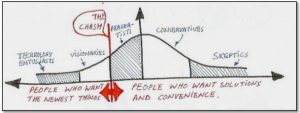
where the majority adopt the innovation and then sink again. He also stated that the population lying before the chasm are the people who want the newest things while the population lying after the chasm are the people who want solutions and convenience.The real challenge lies in crossing the chasm, i.e., winning the heart of the 84% who believe in solutions and convenience. Thus, knowing the right time of chasm crossing will certainly help in planning for better adoption of any innovation (Anonymous n.d.).
c. The innovator’s dilemma: Sustaining &disruptive innovations
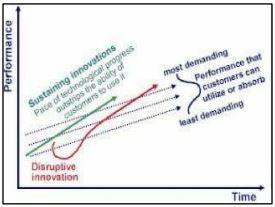
Clayton M Christensen (1997) in his bestselling book ‘The Innovator’s Dilemma’ asks the question as to why successful companies often can’t capitalize on the opportunities brought about by major changes in their market. He has mentioned two types of technologies, i.e. sustaining and disrupting technologies. Sustaining technologies are technologies that improve product performance or are the technologies that involve improving an already established product. Disruptive technologies, on the other hand, are innovations that result in worse product performance especially in the near term. He explains that disruptive innovations cause problems as they don’t initially satisfy the demands of even the high end market; hence the larger companies ignore them until they become more profitable. These technologies later even surpass the sustainable technologies and satisfy market demand at lower prices, thus leaving behind the larger companies that didn’t invest in disruptive technologies beforehand.
d. The cyclic innovation model
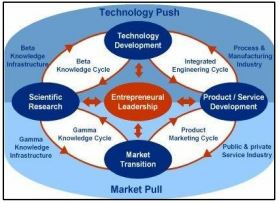
GuusBerkhout conceived of this model and remarked that the successful market introduction of products and services is a cyclic process with interactions between different actors from various disciplines. This model reconciles the ‘technology push’ model and the ‘market pull’ model and explains as to why a holistic multi-disciplinary approach is needed to facilitate an effective innovation system (Berkhout 2017).
e. Open innovation
Henry Chesbrough (2003) in his book ‘Open Innovation’ describes the transition from the traditional internally focused ‘closed’ innovation paradigm to an ‘open’ innovation paradigm. He explains in detail the characteristics of open innovation and the advantages it has over the traditional closed innovation.
f. Maloney’s 16% rule
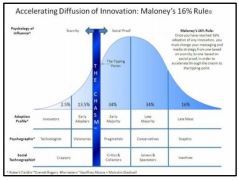
The ‘Maloney’s 16%’ rule is meant for accelerating the diffusion of any innovation. The rule states that once 16% adoption of an innovation has occurred, one must change the media and messaging strategy from one based on scarcity to one based on social proof in order to accelerate through the chasm to the tipping point (Maloney 2010).
g. Innovation systems
Though originally developed to understand industrial innovation, the innovation systems framework has been increasingly used to understand the process of knowledge generation and used in agriculture. Innovation systems can be defined as ‘a network of organisations focussed on bringing new products, new processes and new forms of organisation into social and economic use, together with institutions and policies that affect their behaviour and performance’(World Bank 2006). Under the framework of Agricultural Innovation Systems (AIS), innovation is currently understood as an interactive process through which knowledge is generated, accessed and put into use.
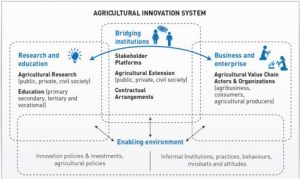
It is not a linear process of science developing new knowledge and transferring it to the extension system for wider dissemination. Innovation requires a combination of technical, organisational and institutional adaptation. New investments and partnerships are required to couple technological innovation with organisational and institutional change (Hall et al, 2010). Central to the innovation process are the interactions among a large number of actors having complementary knowledge and expertise. “This process quite often needs to be facilitated as actors often need an initial push or opportunity to break barriers against joint discussion, action, sharing, and learning (increasingly referred to as brokering) (Klerxx and Leuwis, 2009).
Extension and advisory services (EAS) are integral to the AIS. Within the AIS, EAS should ideally play the role of a‘bridging’ organization, linking the different bits of knowledge held by different actors, and facilitate its application and use, thereby leading to innovation.But to perform this role,EAS need new capacities at different levels (Sulaiman and Davis 2012).Hence, it becomes pertinent to study AIS when we talk about a particular technology as the adoption of any technology is governed by several other factors,which we generally do not consider under the diffusion of innovations paradigm.
END NOTE
As extension professionals, we need to upgrade and enrich our understanding on diffusion and innovation. Our extension curriculum is currently lagging behind in terms of new insights, from both the theory as well as the application of diffusion and innovation studies. The existing course on ‘diffusion of innovation’ for extension scholars doesn’t include the current breakthroughs and developments this branch of knowledge has adopted. Curricular reforms in extension are long overdue and these developments in diffusion and innovation studies should figure in such efforts.There are many new topics in extension that have come up recently or been upgraded with, but here I have only touched on the important concepts on diffusion of innovations which I have found useful. As scholars of agriculture extension we should be ready to familiarize ourselves with the ongoing developments in our discipline and share the same with our peers.
References
Anonymous.N.d Book summary: Crossing the chasm – Bizthoughts. Available at https://eva.fing.edu.uy/pluginfile.php/82462/mod_resource/content/0/Crossing_the_chas m_summary.pdf
Berkhout G.2017. Cyclic innovation model (CIM). Available at http://www.aj-berkhout.com/Cyclic%20Innovation%20Model/
Christensen,C.1997. The innovator’s dilemma: when new technologies cause great firms to fail. Harvard Business Review Press. Available at http://pmonline.org.ua/pluginfile.php/202/mod_data/content/1124/Clayton%20M.%20Christensen%20-%20The%20Innovators%20Dilemma.pdf
Chesbrough, H. 2003. Open Innovation: The New Imperative for Creating and Profiting from Technology. Cambridge, MA: Harvard Business School Press.
Gartner Research. 2018. Gartner hype cycle. Accessed from https://www.gartner.com/technology/research/methodologies/hype-cycle.jsp
Hall, A. J, J. Djikman and R. Sulaiman V. (2010). Research into Use. Investigating the Relationship between Agricultural Research and Innovation, UNU MERIT Discussion Paper (2010-44) United Nations University-Maastricht Economics and Social Research and training centre on Innovation and Technology, Maastricht, The Netherlands.
Klerkx, L. and Leeuwis, C. (2008). Matching Demand and Supply in the Agricultural Knowledge Infrastructure: Experience with Innovation Intermediaries, Food Policy, 33 (3), 260-276.
Maloney. 2010. The secret to accelerating diffusion of innovation: The 16% rule explained.
Available at https://innovateordie.com.au/2010/05/10/the-secret-to-accelerating-diffusionof-innovation-the-16-rule-explained/
Moore,A Geoffrey. 2014. Crossing the chasm. In: Marketing and selling disruptive products to mainstream customers. Third edition.Harper Collins Publishers.
Rogers, EM, and Shoemaker, FF. 1971. Communication of innovations; Across-cultural
approach.New York: Free Press.
Rogers, EM. 1962. Diffusion of innovations. New York: Free Press.
Sulaiman, VR, and Hall A. 2002. Beyond technology dissemination – Can Indian agricultural extension re-invent itself? Policy brief 16. ICAR-National Institute (formerly Centre) of Agricultural Economics and Policy Research. http://www.ncap.res.in/upload_files/policy_brief/pb16.pdf
Sulaiman VR, and Davis, K.2012.The “New Extensionist”: Roles, strategies, and capacities to
strengthen extension and advisory services. Position Paper.Global Forum for Rural Advisory
Services.Accessed from: https://www.g-fras.org/en/knowledge/gfraspublications.html?download=126:the-new-extensionist-position-paper
Tropical Agriculture Platform. 2016. Common framework on capacity development for
agricultural innovation systems: Conceptual background. CABI, ,
https://www.cabi.org/Uploads/CABI/about-us/4.8.5-other-business-policies-andstrategies/tap-conceptual-background.pdf
Wikipedia. 2018. Hype cycle. Available at https://en.wikipedia.org/wiki/Hype_cycle
World Bank 2006. Enhancing agricultural innovation: How to move beyond strengthening research Available at: http://siteresources.worldbank.org/INTARD/Resources/Enhancing_Ag_Innovation.pdf

Ms.Archana Bhatt is a final year Doctoral Scholar (Agricultural Extension) in the Dairy Extension Division of ICAR-National Dairy Research Institute, Karnal, Haryana, India. (Email: archanabhatt1991@gmail.com)

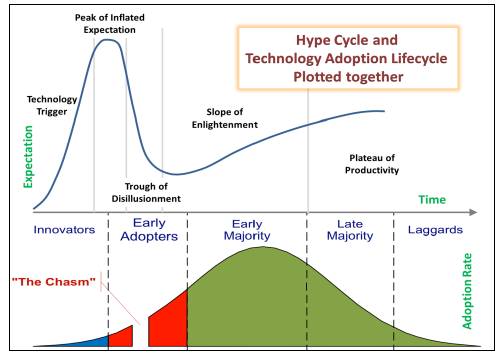
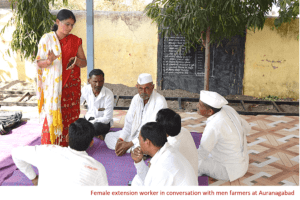

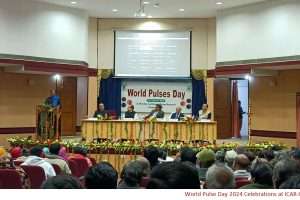
“I congratulate Ms Archana Bhatt on coming out with a thought provoking and innovative blog on diffusion research. Most of our faculty and students do not review the literature thoroughly before initiating a project. This is one of the main reasons for their inability to develop clarity on the basic concepts and the latest happenings in the area of their interest. This concern was expressed by several extension professionals Drs. Rasheed, Sethuraman Sivakumar, Mahesh Chander etc in AESA blogs. Organisations like CRISP, MANAGE , IVEF etc are addressing this issue of improving the capacity of the faculty as well as the students. It helps a lot if our students go through the publications of CRISP “Manual on Good practices in extension research and evaluation “ , AESA working paper on Extension Research in India and some of the books ( depending up on their areas of research) form the list of “ Fifty publications every extension professional should read”etc.
In fact Agricultural Extension professionals owe a lot to AESA for its efforts in bringing out useful information through its site. As Ms Archana has pointed out that required information is available for those who have the will to access it.
“Congrats to Archana for the excellent blog. Hope such thought provoking blogs will be an eye opener for the extension professionals who are engaged in teaching
How many of our teaching professionals are updating their knowledge and skills? It’s a big question. It’s always necessary to discuss about ‘why’ of a concept. We often stop with ‘what’.
As Simon Sinek explains in his book “Start with why?”, people do not buy what you sell, but buy why you sell it. This is a reflection of innovation in marketing.Expecting more such innovative blogs from Archana”
“Thanks for sending an interesting blog. An youngster out of passion for excellence in the profession alerts/craves for attention of colleagues to open their eyes to exciting professional developments to do business differently (curricula, teaching, learning, practice),remain relevant and justify their worth in life. I enjoyed reading (she inspires me as well to go into their detailis) the her briefs about 7 new developments in methodologies to understand and practice diffusion of modern innovations. Lot needs churning of them along with promising others to develop our own theory of diffusion of innovations in cutting edge sciences. Her hidden message if I have understood is that if the profession is not loved and cared, it is a disservice and future will not excuse us! I find lot of youngsters with sparks in your blogs and communications, but the management and senior peers are busy with routine management and mundane issues as to how run the extension service so that it will not collapse. But I have a hope that youngsters like Ms.Bhat supported with and encouraged by ICONS like you can bridge the gap (chasm) between early birds with sparks and late birds with inertia in the profession, your profession can regain its preeminence status soon!
Heartiest congrats to Ms.Archana!”
A blog on a topic long due- Congratulations! to Archana for her excellent efforts and to AESA for its continuous efforts to develop the extension education discipline.
A very good attempt to bring new developments in the diffusion approach proposed by Rogers and its recent developments. In general, Rogers diffusion theory is a foundation of various models developed to understand diffusion and adoption. However, several models were developed in the field of marketing and information technology using the diffusion approach to understand and predict technology adoption. In marketing, diffusion models have been used traditionally for capturing the lifecycle dynamics of a new product, for forecasting the demand for a new product, and as a decision aid in planning for promoting the products In my opinion, the diffusion approach provides a foundation on which several models may be developed to understand the technology behaviour, its life cycle, adoption, etc. Traditionally, the extension discipline is obsessed with adoption and adoptor categories and efforts are on to redefine them. However, the technology diffusion and adoption cant be generalised into few categories as it is largely depending on technology life cycle (e.g. most pesticides have only five years of life before a new variant captures the market; a variety will have 5-10 years life cycle) and availability and access to technologies at the potential adoptors’ place. These aspects are very important factors which determine diffusion of technology and its adoption, but extension has a very little or no focus on these aspects. Besides, the technology diffusion and adoption can be assessed both in cross-sectional or longitudinal methods depending on the nature of technology. In both approaches, the theory, model and methods of assessment are different. In general, extension professionals are expected to maximise the adoption of the technology and assess its impact. This job requires a rigorous and deterministic approach of assessing adoption, forecasting and predicting the technology status, replacing the technology with new variants based on technology life cycle, etc. It is basically a TECHNOLOGY MANAGEMENT job and we may need a long-term approach for this. In this context, our approach should go beyond understanding the diffusion process and assessing the adoption using limited parameters. We may have to develop a database of technologies, define their lifecycle, conduct longitudinal research to assess the technology diffusion in the user system, improve the technology availability at the potential users place, replace old technologies with new variants, forecast the performance of the technology using deterministic models, predict the outputs, outcomes and impacts, provide suggestions to technology developers on performance of existing technologies and suggest new variants based on users needs and preference and so on. This blog paper definitely brings new perspectives into the technology diffusion process, but we need to use this knowledge to conduct deterministic work to manage the technology in a long term.
Congratulations Archana, good one. Keel it up your good going…..
Very nice to see this kind of basic works in extension….I hope not only transfer of technology…the science behind that need to be found out through concrete therotical back up from extension scholars …
S V N RAO: “I congratulate Ms Archana Bhatt on coming out with a thought provoking and innovative blog on diffusion research. Most of our faculty and students do not review the literature thoroughly before initiating a project. This is one of the main reasons for their inability to develop clarity on the basic concepts and the latest happenings in the area of their interest. This concern was expressed by several extension professionals Drs. Rasheed, Sethuraman Sivakumar, Mahesh Chander etc in AESA blogs. Organisations like CRISP, MANAGE , IVEF etc are addressing this issue of improving the capacity of the faculty as well as the students. It helps a lot if our students go through the publications of CRISP “Manual on Good practices in extension research and evaluation “ , AESA working paper on Extension Research in India and some of the books ( depending up on their areas of research) form the list of “ Fifty publications every extension professional should read”etc.
In fact Agricultural Extension professionals owe a lot to AESA for its efforts in bringing out useful information through its site. As Ms Archana has pointed out that required information is available for those who have the will to access it.
I wish her success in her professional endeavour” “I congratulate Ms Archana Bhatt on coming out with a thought provoking and innovative blog on diffusion research. Most of our faculty and students do not review the literature thoroughly before initiating a project. This is one of the main reasons for their inability to develop clarity on the basic concepts and the latest happenings in the area of their interest. This concern was expressed by several extension professionals Drs. Rasheed, Sethuraman Sivakumar, Mahesh Chander etc in AESA blogs. Organisations like CRISP, MANAGE , IVEF etc are addressing this issue of improving the capacity of the faculty as well as the students. It helps a lot if our students go through the publications of CRISP “Manual on Good practices in extension research and evaluation “ , AESA working paper on Extension Research in India and some of the books ( depending up on their areas of research) form the list of “ Fifty publications every extension professional should read”etc.
In fact Agricultural Extension professionals owe a lot to AESA for its efforts in bringing out useful information through its site. As Ms Archana has pointed out that required information is available for those who have the will to access it.
I wish her success in her professional endeavour”
“I congratulate Ms Archana Bhatt on coming out with a thought provoking and innovative blog on diffusion research. Most of our faculty and students do not review the literature thoroughly before initiating a project. This is one of the main reasons for their inability to develop clarity on the basic concepts and the latest happenings in the area of their interest. This concern was expressed by several extension professionals Drs. Rasheed, Sethuraman Sivakumar, Mahesh Chander etc in AESA blogs. Organisations like CRISP, MANAGE , IVEF etc are addressing this issue of improving the capacity of the faculty as well as the students. It helps a lot if our students go through the publications of CRISP “Manual on Good practices in extension research and evaluation “ , AESA working paper on Extension Research in India and some of the books ( depending up on their areas of research) form the list of “ Fifty publications every extension professional should read”etc.
In fact Agricultural Extension professionals owe a lot to AESA for its efforts in bringing out useful information through its site. As Ms Archana has pointed out that required information is available for those who have the will to access it.
I wish her success in her professional endeavour” “I congratulate Ms Archana Bhatt on coming out with a thought provoking and innovative blog on diffusion research. Most of our faculty and students do not review the literature thoroughly before initiating a project. This is one of the main reasons for their inability to develop clarity on the basic concepts and the latest happenings in the area of their interest. This concern was expressed by several extension professionals Drs. Rasheed, Sethuraman Sivakumar, Mahesh Chander etc in AESA blogs. Organisations like CRISP, MANAGE , IVEF etc are addressing this issue of improving the capacity of the faculty as well as the students. It helps a lot if our students go through the publications of CRISP “Manual on Good practices in extension research and evaluation “ , AESA working paper on Extension Research in India and some of the books ( depending up on their areas of research) form the list of “ Fifty publications every extension professional should read”etc.
In fact Agricultural Extension professionals owe a lot to AESA for its efforts in bringing out useful information through its site. As Ms Archana has pointed out that required information is available for those who have the will to access it.
I wish her success in her professional endeavour”
Good attempt and worth reading!